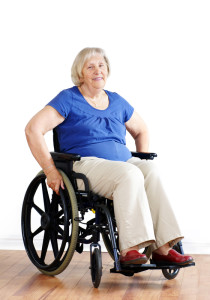The Truth About Home Modification Funding
 Articles that discuss accessible home modifications are frequently accompanied by a list of “great resources to contact for home modification funding”, giving readers the optimistic sense that if they just invest a little time, there is a good chance they can get some financial assistance for making their home more accessible.
Articles that discuss accessible home modifications are frequently accompanied by a list of “great resources to contact for home modification funding”, giving readers the optimistic sense that if they just invest a little time, there is a good chance they can get some financial assistance for making their home more accessible.
Over the years we have contacted an extensive number of organizations from these so called “great funding sources” and were always passed from one person to the next with the majority of the organizations telling us, “I am not sure how we got on a list for funding. No we don’t give out funding, but here is a list of some more people you can try.” And so it continued…and after engaging in hundreds of phone calls over the years, which included calls to the Mayors Office on Disability, Area Agencies on Aging and Independent Living Centers we came to the conclusion that there’s ultimately very little truly available in terms of financial assistance for accessible home modifications.
The minimal financial assistance that is available is primarily designated for veterans, very low-income persons, or vocational rehabilitation programs. If you don’t fall under one of these categories, then your chance for finding funding assistance is very slim. If you do fall under one of these general categories, there is still no guarantee you will receive financial assistance: You will additionally need to be lucky enough to be selected out of a pool of many others who are vying for the same limited funds.
 Ok, so if it is not looking favorable for you to receive some additional financial assistance, but you do want to keep more money in your savings account for the years ahead, you are not completely out of luck. There are still ways for you to be thrifty and save some money through tax deductions, second-hand products, and senior discounts. Depending on your insurance policy, you might be a candidate to receive some limited coverage for equipment and home modifications. Lastly, it may be possible for you to access more readily available cash to cover the costs of the modifications by finding a low-interest rate loan, taking out a home equity line of credit or setting up a reverse mortgage.
Ok, so if it is not looking favorable for you to receive some additional financial assistance, but you do want to keep more money in your savings account for the years ahead, you are not completely out of luck. There are still ways for you to be thrifty and save some money through tax deductions, second-hand products, and senior discounts. Depending on your insurance policy, you might be a candidate to receive some limited coverage for equipment and home modifications. Lastly, it may be possible for you to access more readily available cash to cover the costs of the modifications by finding a low-interest rate loan, taking out a home equity line of credit or setting up a reverse mortgage.
Below you’ll find information covering each of these options.
1. Home Modification Tax Deductions
The IRS allows you to deduct some equipment and accessible home modifications as medical expenses if the modifications alone, or in combination with your other unreimbursed medical expenses, exceed a set percentage of your adjusted gross income for the year – and you are paying for them out of your own personal savings account (not a health savings account). Effective on January 1, 2013 the IRS reports that if you are an individual over the age of 65, you may deduct medical expenses that exceed 7.5% of your adjusted gross income, and if you are an individual under the age of 65, you may deduct medical expenses that exceed 10% of your adjusted gross income. In order to better guarantee that you can claim accessible equipment and home modifications as a tax deduction, it is best to include a “Letter of Medical Necessity” from your doctor indicating the items are medically necessary for you to function safely and independently.
 The IRS is usually willing to recognize the following items as medically deductible: Installation of a ramp, vertical lift, elevator, grab bars or hand rails; modification of stairs; widening of doorways; modification of smoke and fire alarm systems; lowering of kitchen cabinets; grading of the ground for easier home access; personal supplies such as diapers and special foods; cost of prescription drugs; medical equipment; medical and dental costs; medical insurance premiums, travel expenses for treatment and cost of long-term care insurance. For more information on items that can be deducted, see IRS Publication 502, Medical & Dental Expenses, or for questions call the IRS at (800) 829-1040. Talk to your tax advisor to learn more about what tax credits or deductions you are eligible to receive.
The IRS is usually willing to recognize the following items as medically deductible: Installation of a ramp, vertical lift, elevator, grab bars or hand rails; modification of stairs; widening of doorways; modification of smoke and fire alarm systems; lowering of kitchen cabinets; grading of the ground for easier home access; personal supplies such as diapers and special foods; cost of prescription drugs; medical equipment; medical and dental costs; medical insurance premiums, travel expenses for treatment and cost of long-term care insurance. For more information on items that can be deducted, see IRS Publication 502, Medical & Dental Expenses, or for questions call the IRS at (800) 829-1040. Talk to your tax advisor to learn more about what tax credits or deductions you are eligible to receive.
Under normal circumstances, if you were to make modifications that increase the value of your home, you would run the risk of incurring a higher tax rate. The IRS is usually willing to allow you to forego this tax increase, however, when modifications have been performed for medically justifiable reasons. The modifications listed in the paragraph above tend to fall under this consideration. Adding a whole new room or wing to the house, may not. Consult with your financial advisor to determine which modifications can be excluded from increasing your home’s value.
2. Green Tax Credits
Any time you are remodeling, consider using energy efficient products, which will help you to lower your future energy bills. Many energy efficient products are also candidates for 10%-30% in federal tax credits. Visit Energystar.gov for a list of products that qualify for tax credits.
3. Recycled Medical Equipment
It is possible to find gently used (or in some cases never used) equipment second hand from a variety of sources. This is a great way to save money, but it is important to be cautious about the age and model of the products you opt to purchase second-hand. If you purchase a simple bath bench, the age and model won’t matter much; however, if you purchase a more expensive used piece of equipment (E.g a stair lift), there can be some drawbacks to buying second-hand, namely that second-hand equipment doesn’t normally come with a warranty and replacement parts for older equipment models may be difficult or impossible to find.  If possible, try to avoid purchasing second-hand equipment models that have been discontinued by the manufacturer so that replacement parts will be more readily available.
If possible, try to avoid purchasing second-hand equipment models that have been discontinued by the manufacturer so that replacement parts will be more readily available.
a) Local resources for used equipment
Contact local companies who sell the type of equipment you are seeking. Many vendors who sell new equipment also have programs set up to buy back used equipment, so they may have recent used models on hand that you can purchase for cheaper rates. Some may even be willing to offer you a limited warranty on the installation of used equipment.
Check online or ask your doctor or rehab therapist if they know of any general medical equipment recyclers or loan supply closets in your area. Many loan supply closets offer equipment for severely discounted rates, or in some cases even for free. If you have a diagnosis that has an affiliated association (e.g. MS Association, Cerebral Palsy Association, Arthritis Association) try contacting the local branch to see if they offer loaner or recycled equipment.
b) Online resources for used equipment
If local vendors, installers, or associations don’t have any used equipment models on hand you can check one of the online resources listed below. Prior to purchasing a used piece of equipment online that requires installation, we recommend that you make sure you have a family member or local person lined up who is willing to install it for you. Many installers will refuse to install certain equipment models due to the equipment’s potential history of problems, so it would not be helpful to purchase a used piece of equipment that nobody is willing to help you install.
| Web Address | Description | |
| www.disableddealer.com | Find scooters, lifts, and more for sale by owner | |
| www.usedhme.com/ | Medical Equipment for sale by owner | |
| www.ebay.com | New & used equipment of all kinds for sale by owner | |
| www.craigslist.org | Equipment of all kinds offered for sale or for free by owner |
4. Senior Discounts
Ask contractors, installers and equipment vendors if they offer reduced rates for seniors. Many will offer reduced rates or sliding-scale fees based on income and ability to pay.
5. Long Term Care Policy
Some long term care policies will cover a portion or all of the home modifications. If your policy does allow you to use funds for home modifications, make sure to clarify how using these funds for this purpose will affect your overall policy.
6. Insurance Coverage of Home Modifications
Medicaid offers Home and Community Based Services (HCBS) through a waiver program and reimbursements for home modifications will ‘sometimes’ be considered under this waiver program. All states have different plans set up. If you are a Medicaid recipient, call your State Department of Health and Human Services for more information.
 Basic Medicare plans are not set up to pay for home modifications, but they do assist in paying for some durable medical equipment for the home, such as hospital beds, crutches, walkers, ventilators, and wheelchairs. Medicare has different payment methods in place for different types of equipment; some may be rented, other equipment may be purchased, and some items can be set up as ‘rent to own’. In most cases, you will be responsible for 20% of the cost of the equipment and Medicare covers the rest. In all cases the doctor must prescribe the equipment as ‘medically necessary’ in order for Medicare to cover it, and both the doctor and the equipment supplier must be enrolled in Medicare for you to be eligible to receive coverage. For more information on what is covered, visit Medicare.gov.
Basic Medicare plans are not set up to pay for home modifications, but they do assist in paying for some durable medical equipment for the home, such as hospital beds, crutches, walkers, ventilators, and wheelchairs. Medicare has different payment methods in place for different types of equipment; some may be rented, other equipment may be purchased, and some items can be set up as ‘rent to own’. In most cases, you will be responsible for 20% of the cost of the equipment and Medicare covers the rest. In all cases the doctor must prescribe the equipment as ‘medically necessary’ in order for Medicare to cover it, and both the doctor and the equipment supplier must be enrolled in Medicare for you to be eligible to receive coverage. For more information on what is covered, visit Medicare.gov.
Medicare has ‘sometimes’ been know to cover items not found on their standard list of covered items if the request is prescribed by a doctor with a corresponding “Letter of Medical Necessity”. The letter must give strong justification to support why it is mandatory for you to have the equipment to be able to function safely and independently.
Medicare Advantage Plans: Are you enrolled in a Medicare Advantage Program? If so, these programs now have the flexibility to begin offering Home Modifications as a Supplemental Benefit. Visit Medicare.gov to learn more.
Private Medical Insurance Provider: If you have a private medical insurance provider, they may cover some of the costs for equipment or home modifications. Contact your provider to request more detailed information on what they do and don’t cover.
Other Coverage: If your need for home modifications came about as the result of an accident or injury, you may find assistance from an automobile insurance policy, worker’s compensation program, state catastrophic accident insurance plans, or a medical trust fund.
7. Loans
Different financial institutions over the years have been willing to offer low interest rate loans to seniors and individuals with disabilities. These offerings change continually and are different from state to state, so it is best to try contacting the National Council on Independent Living 877-525-3400 (www.ncil.org), your local Council on Independent Living (CIL) or your local Area Agency on Aging to see if they are aware of anyone offering low interest loans in your area.
8. Reverse Mortgage
Reverse Mortgages have had quite a bad rap for many years, but they are more highly regulated now and are resurfacing again as a potentially good option for people who need additional cash in order to continue living at home. In order to qualify for a reverse mortgage, you must be at least 62 years of age and own your own home.
 There are different types of reverse mortgages, so it is ideal to talk to a financial advisor before settling on one. Rates can differ significantly among lending institutions, so it is also best to do some shopping-around. If you do consider a reverse mortgage, choose one that is federally insured and make certain you understand all the loans’ details, including the upfront fees, legal requirements, and payment terms.
There are different types of reverse mortgages, so it is ideal to talk to a financial advisor before settling on one. Rates can differ significantly among lending institutions, so it is also best to do some shopping-around. If you do consider a reverse mortgage, choose one that is federally insured and make certain you understand all the loans’ details, including the upfront fees, legal requirements, and payment terms.
One of the good things about a reverse mortgage is that there is usually no required loan payments until the home is sold, the last borrower (co-signer) dies or the last borrower moves out of the home for more than a year. This final stipulation is the part that sometimes catches people. According to the terms for most reversed mortgages you must reside in the home and you cannot rent out the home while you are living somewhere else. If you need to stay in a nursing home at some point for a year or more while recovering from an injury or illness, be aware that you may be required to begin making loan payments.
9. Life Settlements or Viatical Settlements
As a last resort, people will sometimes opt to sell their life insurance policy to a third party for a sum of money, which can then be used to pay for home modifications and home care; thereby giving the person more funds to live at home for longer. Be sure to talk to your tax advisor before considering this option because it may have an affect on your supplemental social security, Medicaid or tax bracket for the year in which it is sold.
10. Veterans’ Benefits
If you are a veteran, or spouse of a veteran, you may be eligible to receive grants to assist you in paying for medical equipment and home modifications. The VA offers the Specially Adapted Housing (SAH) grant, the Special Home Adaptation (SHA) grant, and the Home Improvement and Structural Alterations (HISA) grant. The VA also offers some home loans that may assist you to purchase a new home and make modifications. Additionally ask your local Veterans Benefits Office or VA health care facility about whether they have an equipment program available for new or recycled products.
VA benefits can be complex and difficult to navigate. To learn more about eligibility requirements, call the VA’s Health Benefits Service Center at (877) 222-VETS, or visit the VA’s web site (click here).
11. Vocational Rehabilitation
If you are an individual with a disability who is currently employed or would like to be employed, you may be a candidate for financial assistance for home modifications that will enable you to maintain employment. Contact your state’s Department of Vocational Rehabilitation.
Another alternative is a program called PASS offered by the Social Security Administration specifically for people with disabilities who are interested in returning to work. This program does not pay for the equipment and services, but will work with eligible individuals to set up a payment plan, which can thereby enable individuals to get the items and services needed to be able to return to work. To learn more about PASS click here.
12. Funding for Individuals with Very Low Income
As we mentioned in the beginning, there is very little funding assistance available for home modifications. But if you are truly cash strapped with extremely limited income, you may be a candidate for government funding that is funneled down through the states. Another avenue you might try is to reach out for assistance from associations or community service organizations.
community service organizations.
Start by contacting your local ‘Area Agency on Aging’ and your local ‘Center for Independent Living’ to learn about programs offering assistance for individuals with low income. Also try contacting local community service organizations such as Kiwanis, Lions Club, Elk Club, Jaycees, Knights of Columbus, Masonic Lodge and Rotary clubs to ask if they have a program set up to assist with funding and/or services to assist people in the community with home repairs.
If you have a specific injury or disease that is supported by an association, contact them directly to ask about funding (e.g. Multiple Sclerosis Society, Cerebral Palsy Association, Spinal Cord Association, Arthritis foundation). Also try contacting National Organizations such as the United Way and National Easter Seals. If you are part of a church or other religious institution ask if they have a program set-up to offer financial assistance or home repair assistance for a senior or person with a disability.
The United States Department of Agriculture and Rural Development offers a Rural Repair and Rehabilitation Grant or Loan to very low-income homeowners to repair, improve, or modernize their dwellings. For eligibility requirements, visit usda.gov. To view their guide for loan and grant applicants, visit ruralhome.org.
State Assistive Technology Programs may offer loans or assistance in obtaining new or used assistive technology for the home. Some have equipment they can lend to you, so you can try it out before you buy it and make sure it is really appropriate for your needs. For more information, visit resnaprojects.org.
Rebuilding Together is a national organization that performs home repairs and services for free for low-income homeowners, elderly-at-risk, veterans and military families, families with children, people living with disabilities, and victims of disaster. Contact your local chapter to learn about eligibility requirements. For more information, visit rebuildingtogether.org.
This article is intended for informational purposes only and should not be taken as legal or tax advice. Consult your attorney or CPA.
Safety Enhancing Products on Amazon.com
Thousands of Home Care Solutions!
There are a countless number of great tricks, techniques and equipment solutions possible for adapting the home. In subsequent articles we will go into depth on specific products and solutions to help make daily tasks easier and your home more livable.
Check back often, or sign up for our newsletter to keep up to date on the latest trends and solutions to help you remain safe and independent in your own home.
More Topics You May Be Interested In:
- 12 Barriers to Living Independently – and 36 Ways to break them down!
- Your Own Home vs. Assisted Living Facility: Cost Comparison
- Buying a Walk-in Tub – Your Biggest Mistake?
- Invest in Your Independence
- Getting In & Out of the Bathtub: Benches, Lifts, and Transfer Chairs
(c) Homeability.com
